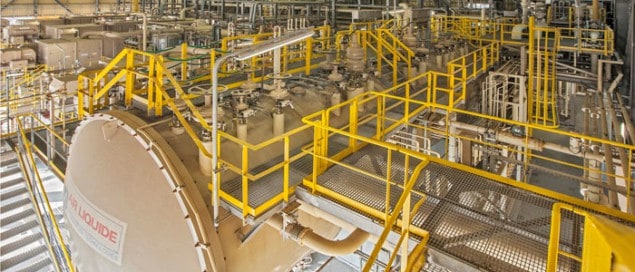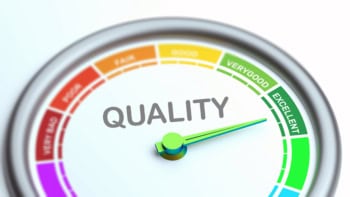The ongoing political crisis involving Qatar has highlighted the fragility of the global helium supply, of which the Gulf state is a major producer. In this exclusive news analysis piece, Richard Clarke looks at the geopolitical and economic vulnerabilities of the helium supply chain and explains how technological advances could make these problems a thing of the past.

The world is not running out of helium. It never will. For one thing, there’s 3.8 billion tonnes of the stuff bearing down on us. The Earth’s atmosphere contains helium at a concentration of 5.2204±0.0041 ppmv, and as far as we can tell, it’s at equilibrium: there is no sign of anthropogenic helium emissions, and the rate of helium generated from radioactive decay in the Earth’s crust seems to balance out the flow of helium ions from the upper atmosphere into space.
So, with all that helium up there, should we worry about helium supplies? Unfortunately, the answer is “probably”. The helium used in laboratories, hospitals and semiconductor-fabrication facilities around the world arrives there via a precarious, finely tuned cryogenic supply chain. The various parts of this chain are vulnerable to disruption in a number of ways, and if you start taking any of them away, the result is a game of helium Jenga: although there is a certain amount of resilience, each loss reduces the system’s stability, and there is always a chance that removing one more piece will bring the tower crashing down, regionally if not globally.
Rationed supply
The latest candidate for that crucial piece is Qatar. The tiny Gulf state produces more than 25% of the world’s helium, but earlier this month, a dispute with its neighbours meant that it could not export it. If this political dispute is not resolved, and the signs are not encouraging, low-temperature physics labs and other critical helium users in Europe and East Asia could catch a cold. No one wants to be “on allocation” – legal jargon for a rationed supply – but scientific or medical users could be hit particularly hard, especially since there is no special pleading or prioritization system: reductions are applied as contracts allow, regardless of the user’s relative importance. During the last major helium crunch, in 2013, some facilities had their supply cut by half or more.
To understand how this situation came about, it helps to know how helium is produced, and how the market for it developed. As already noted, helium is plentiful in the Earth’s atmosphere, but if we had to extract it from there, low-temperature physics as we know it would have been greatly hindered because of the associated monetary and energy costs. Fortunately for physicists – as well as patients in MRI scanners, aerospace engineers (helium is used to propel hydrogen rocket fuel), data centres (their hard drives are filled with helium to boost storage capacity) and many others – certain strata in the Earth’s crust contain giant accumulations of natural gas, nitrogen and helium, all just waiting to be found by geologists.
Scientific or medical users could be hit particularly hard, especially since there is no special pleading or prioritization system
The problem is that helium is the Cinderella of industrial gases. Although it critically underpins 21st century technology – the materials scientist Mark Miodownik dubbed it a “super element” in a 2017 BBC television programme – it is nevertheless habitually neglected, vented and wasted. In short, the decision to recover and purify helium from a particular gas field depends entirely on the price of natural gas, the size of the field and the concentration of helium within it.
Airships and rockets
This has not always been the case. A century ago, helium was a cutting-edge military technology, a potential replacement for flammable hydrogen in airships. Realizing this, the US government started recovering the small-but-useful percentage of helium found in certain gas fields across the Great Plains, notably at Cliffside in the Texas panhandle. By the 1960s, the emphasis had shifted from airships to rockets, and a huge stockpile of helium was being accumulated for use in the Apollo programme: the Saturn V rocket that launched astronauts toward the Moon in July 1969 used around 65 tonnes of helium to purge the cryogenic tanks and lines, and to propel its liquid-hydrogen fuel. At that time, the only other significant helium source was in Russia, and so helium became a Cold War gas, prized by both sides.
Indirectly, however, the space race also led to the development and refinement of low-temperature cryogenics technology, and this opened up new possibilities for helium. While Cold War adversaries were sending up astronauts and cosmonauts, natural gas was beginning to be liquefied on an industrial scale for export in special tankers – chiefly to Japan, an emerging but energy-poor nation. One of the first liquid natural gas (LNG) plants was built at Arzew, Algeria, and it yielded an unexpected bonus. Although Algeria’s giant Hassi-R’mel gas field contains just 0.17% helium, officials at the Arzew LNG plant discovered that the non-condensable residue or “purge gas” from the main condenser was around 50% helium. Initially, this gas was simply vented, but through patient negotiation, a team from the firm Air Products persuaded the Algerians to form a joint-venture company to build a helium refinery and liquefier.
The development of this plant made it possible to export pure liquid helium in special, super-insulated tanks to Japan, Europe and beyond (previously, nearly all of Europe’s helium had come from the US). The first helium shipment left Arzew in 1995, and since then, the idea of recovering helium during the liquefaction of natural gas has caught on as the LNG market has expanded. Helium is now routinely recovered from LNG plants in Algeria, Australia and, of course, Qatar, where a project called Helium 3 was due to boost the country’s share of the global helium market from 25% to more than a third upon the completion of a third helium liquifier in early 2018.
The latest weak link
That, at least, was the plan before Qatar’s neighbours imposed sanctions on it. Ironically, up to that point, the helium market had been returning to some kind of equilibrium after a period of tremendous upset triggered by the US Helium Privatization Act of 1996. The sole purpose of this act was to sell off America’s helium reserve, and thus to recover the cost of creating and maintaining the country’s helium stockpile. At a stroke, it effectively made the US government the world’s biggest player and price setter in the helium market. Many smaller refiners dropped out, unable to compete against the flood of helium emerging from the Cliffside field. By 2013 the Act’s work was done, and plans were duly made to shut down production at Cliffside. Only intense lobbying persuaded the US Congress not to cut off the world’s helium supply at a stroke, and at the last minute, the Helium Stewardship Act of 2013 averted a total shutdown.
The knock-on costs to a scientific or medical facility of being without helium far exceed the costs of the helium itself
In some ways, this was a wake-up call for the industry. Today, there are around 20 significant helium refiners in the world. But even though only a few per cent of the world’s supply is auctioned in Texas (and the Cliffside gas field will be depleted by 2021), the US still effectively sets the price. This is not very satisfactory, but no one has yet come up with a better idea of how to price helium.
Hopefully, Qatar’s absence from this market will be temporary. But both sides in the dispute seem to be digging in for the long haul, and the US – which has long acted as an intermediary in the region – is being ambivalent. Even if the dispute is resolved within a few weeks, the knock-on effects will be considerable. Qatar is still shipping LNG to customers via carriers that berth at special facilities near Ras Laffan Industrial City at the northern end of the country. However, Qatar’s containerized imports and exports, including cryogenic helium tanks, are normally sent by road through Saudi Arabia and on to the major port of Jebel Ali in the United Arab Emirates (UAE). The decision of the UAE and Saudi Arabia (with Egypt and Bahrain) to impose sanctions meant that this route is no longer open.
Warm containers
With exports thus cut off, the two existing helium liquifiers at Ras Laffan have been shut down. Restarting them will take time, and the hiatus also means that many helium containers will be in the wrong place. Worse, the containers will have warmed up, and re-conditioning them will take time and care – as the low-temperature science community knows from long experience.
In response to this crisis, helium suppliers in Europe and East Asia have begun running down their existing stocks of purified helium. If and when these are exhausted, the dreaded allocations will start, and at that point managers of scientific facilities will be in a tight spot. Most large-scale physics experiments need a certain minimum, long-term helium supply rate. They can get by for a week or two but they will soon be asking how long this blockade in Qatar is going to last. The knock-on costs to a scientific or medical facility of being without helium far exceed the costs of the helium itself.
Creative solutions
Regardless of what happens in Qatar, the overall instability of the helium market means that anxiety about supplies has understandably become the norm, even though terrestrial reserves show no sign of reaching “peak helium” production. Some users have responded with creative solutions. Helium recycling systems such as the one recently installed at the UK’s Rutherford Appleton Laboratory (RAL) reduce both supply anxiety and cost; the RAL system should pay for itself within two years. Another useful strategy is to follow MRI manufacturers in recovering helium refrigerant gas during the decommissioning of old machinery. Minimizing leaks is also crucial, especially for fusion-energy applications. However, if fusion is ever to become a technically (and perhaps economically) viable energy source, engineers need to ensure that the trend of reducing leaks by 3% per cent each year (the so-called “leak learning rate”), achieved at the Joint European Torus and elsewhere, is replicated at ITER and in DEMO, the first fusion power plant.
The real challenge, however, is for the physics community to wean itself off the abundant but intermittent terrestrial helium supply. A confluence of needs – for ultra-high cryogenic system reliability, compactness, low helium inventory and, in space systems, for minimal weight and power requirements – is pushing the community in the direction of alternative technologies such as cryocoolers and pulsed-tube refrigerators. These high-precision heat engines can produce very low temperatures without the need for liquid-helium refills, and their efficiency and reliability is improving continuously. The amount of helium used per watt of cooling power is thus falling dramatically; even though helium is still the refrigerant gas, the inventory and leakage rates of new systems could be met economically through the recovery of helium from the atmosphere.
The helium supply and helium user communities have been innovating for a century now, and this shows no sign of petering out. Both the importance of helium and the anxiety about its supply drive ingenuity. Necessity is, once again, indeed the mother of invention.



